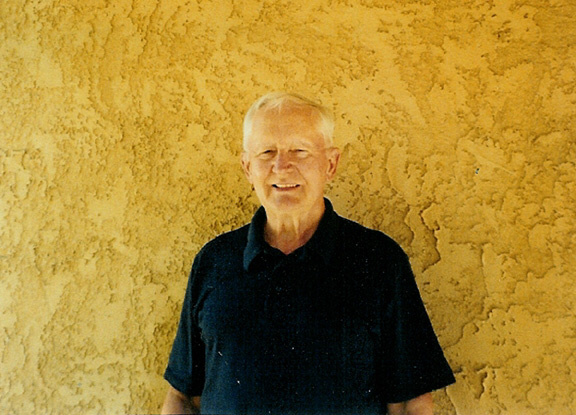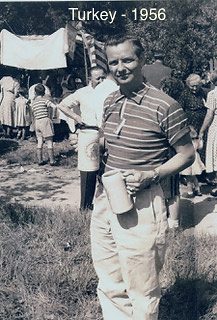


 |
 |
 |




|
|
CIA medal awarded to Louis Setter at 2005 Roadrunners Internationale reunion for his role in training the first CIA U-2 pilots at Area 51.
 The Roadrunners International Association and the Nevada Aerospace Hall of Fame are sadden to announce the final flight of Col Louis Claire Setter, one of the original veterans of the CIA U-2 program at Watertown, later known as Area 51.
The Roadrunners International Association and the Nevada Aerospace Hall of Fame are sadden to announce the final flight of Col Louis Claire Setter, one of the original veterans of the CIA U-2 program at Watertown, later known as Area 51.
Col Louis Claire Setter, USAF Ret, and flight test engineer was born on July 26, 1925, and passed away on October 13, 2019. Setter, after serving for 2 1/2 years in the US Navy during World War II, as a seaman-navigator, graduated from Georgia Tech with a BS in Aeronautical Engineer in 1948. He then entered the US Army Air Corps as a Cadet at Randolph Field, Texas. There, he flew the T6 prop trainer.
In 1949, he discharged from the US Army to enter the US Air Force. Assigned to the 31st Fighter Wing, Turner AFB, Ga., he flew the F-84E and F-84G for air refueling and atomic weapons, participating in developing toss bombing techniques for nuclear weapon delivery.
In 1950, Setter flew an F-84E across the Atlantic Ocean to England for the Fox Able 9.31 Fighter Wing. In 1952, he flew the F-84G across the Pacific Ocean to Japan using celestial navigation, air refueling for KB-29 tankers. Codenamed Fox Peter 1, this was the first jet fighter crossing of the Pacific Ocean. Setter designed and built cruise control computers for long-range jet fighter use. He also created similar controllers for the F-84G, F-84F, T-33, T-39, and U-2. In 1954, Setter served as the Ops Officer, IP, and FE for the F-84 Fighter Squadron, Great Falls, MT.
In 1955, the Strategic Air Command selected Setter as an Instructor Pilot for the CIA's U-2 high-altitude reconnaissance aircraft development at Watertown, Nevada. There, he assisted in developing and testing celestial navigation techniques for pressure suited pilots, designed cruise control computer, and oxygen plotter.
In 1955, Setter became the fourth USAF pilot to fly the U-2. At Watertown, he instructed the CIA to fly the U-2 plane. The CIA assigned Setter as the project flight test engineer at Watertown, where he flew the U-2, T-33, C-47, C-45, U-3A, Navion, Twin Bonanza, and L-20 Beaver.
In 1959, the CIA selected Setter as the U-2 Ops Officer and Commander at North Base, Edwards AFB, CA.
From 1960 to 1964, while assigned to the Edwards AFB, CA's main base as a flight test engineer, Setter continued flying as an Instructor Pilot in the T-33. He flew helicopters, transports, and the F-100 as a test engineer. As the test engineer on the T-33 airstart program, he conducted 299 airstarts. He designed, developed, and tested the T-33 automatic airstart system, which was later retrofitted to over 3,000 T-33s worldwide. As the Tri-Service flight test manager, he flew the Russian MI-4 helicopter.
Promoted to Chief of the Performance, Stability, and Control Branch at the AFFTC (Air Force Flight Test Center), he directed 60 test engineers and produced an average of 50 AFFTC aircraft performance and flying quality test reports per year on all types of USAF aircraft.
In 1965, Setter received an assignment to Tri-Service VTOL SPO at Wright Patterson AFB, Ohio, as the Director of Flight Test and training on XC-142, X-19, and X-22 ground and flight test programs. He directly supervised contractor (Chance Vought) first flight of the XC-142 VTOL transport.
From 196 to 1967, Setter served as the Base Commander to the Antigua Air Station, Eastern Test Range, Caribbean. As the ranking US representative to the local Antigua government, he dealt with the US and foreign Congressmen, Prime Ministers, British Royal Family, and many other VIPs.
From 1967 to 1973, Setter served in Viet Nam as a pilot, IP, and FE on C-7 Caribou STOL Transport planes.
From 1969 to 1973, Setter served at the Tinker AFB, OK, first as an engineer to the Airborne Command Post SPO, and when promoted to colonel, became the Chief of Engineer for the Oklahoma City Air Logistics Depot with over 350 personnel, and responsible for engineer support to the B-52, KC-135, and A-7 fleets and to their engines and avionics.
From 1973 to 1976, while assigned to Headquarters, Logistics Command, Wright-Patterson AFB, Ohio, as the Deputy for Systems, Setter's responsibility included maintaining and modification of all Air Force aircraft. He was the chairman of the CCB (modification board) and the Depot Maintenance Board. He received the Logistics Manager of the Year by the Air Force Association in Washington, DC.
Setter retired from the USAF in 1975 as a colonel with 30+ years, 4400 flying hours in over 40 different types/models of aircraft: fighters, trainers, reconnaissance, helicopters, and transport planes. He attended and graduated from the Engineering School, UC Sacramento, in 1977. He spent three years with Boeing Wichita as the business manager for the VP, Mr. Abe Goo, Project Management. He advanced in 1981-1982 as the site manager for the Boeing Wichita cruise missile tests at Edwards AFB, managing 50 personnel supporting both Boeing Seattle and General Dynamics cruise missile tests. He resigned from Boeing at the conclusion of the cruise missile tests, choosing to remain in the Edwards AFB area to obtain his AA degree in Art, specializing in sculpture at the Antelope Valley College.
In 1983, he joined BDM as an engineer to Headquarters, Royal Saudi air force, Riyadh, Saudi Arabia. He left BDM in 1985 to join the Northrop B-2 program in Pico Rivers, California. As the manager of Support Equipment, he supervised approximately 100 engineers and technicians performing engineering design.
In 1988, Northrop assigned Setter as an engineer at its B-2 Flight Test Support at Palmdale and later at the Edwards AFB test site. He held the additional duty of Northrop's Director of Ethics program at Edwards. He was in charge of the Mission Control Room for over 200 B-2 test missions.
On June 30, 1995, Setter retired from Northrop but returned as Test Director at Edwards AFB at their request. The following year, he began working part-time for the Computer Sciences Corporation as the B-2 Test Director to write new USAF directives for the B-2 follow-on testing. As the lead Test Director, he assisted in training new personnel.
Through September 1999, following the merger of the B-2 organization into the 419th Flight Test Squadron, Setter became the Test Director for B-1, B-2, and B-52 test missions. He wrote numerous new directives and letters as part of the merger operation. He trained new engineers and test directors.
Setter, as a member of the Commander's "Tiger Team," helped instill best practices from the B-2 program to the B-1 and B-52. He served as a member of the Red Team on the Airborne Laser test program utilizing a modified Boeing 747-400.
At the Roadrunners International 2005 reunion, the CIA awarded Louis Setter the Agency Seal Medallion in recognition of his contributions to the National Security mission during the testing and training phases of the U-2 program in the 1950s.
There are no services planned at this time.
 |
 |
 |